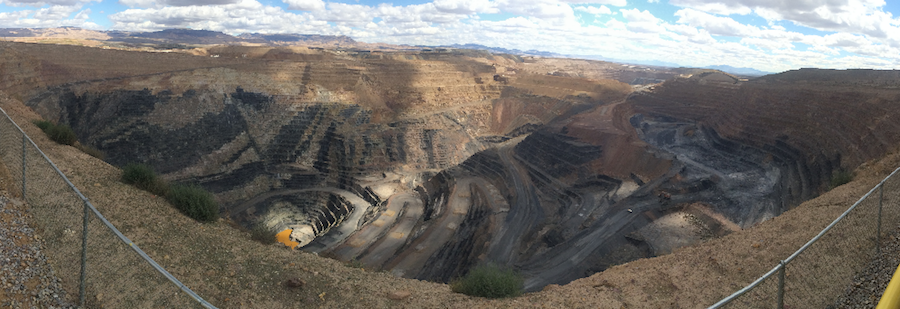Cost-saving nanotechnology set to disrupt gold processing industry

Typical gold mining operation. Photos and graphs by 6th Wave Innovations Corp.
For over a century the gold processing industry has been dominated by one primary material that is used in the cyanide leaching process: activated carbon.
Put simply, gold-bearing ore is crushed into fine particles before being mixed into a pregnant leach cyanide solution that is filtered through activated carbon – sourced mostly from burnt coconut shells.
The gold adsorbed by the activated carbon is then recovered through elution, before being regenerated (baked) in a rotary kiln at around 700 degrees Celsius.
Molecularly imprinted polymer ion exchange resin can increase gold mining profits by about $100 per ounce in processing savings and extra gold recovered in direct comparison to activated carbon, the most widely-used extraction medium.
While it is a popular material for gold recovery, activated carbon has its limitations. The capacity for gold adsorption depends on the metallurgy of the ore, the quality of the activated carbon, the pH of the pregnant solution and other factors.
About 10 percent of the carbon is lost during the process, which adds to the producer’s input costs. Moreover, activated carbon is not highly selective, meaning that other minerals in the pregnant leach solution become trapped within the activated carbon – a problem known as organic fouling. There is also the fouling and adsorption of other metal ions that compete for adsorption with the gold and are also difficult to elute.
There had to be a way to make the process more efficient. The challenge was taken on by Dr. Glen Southard, an expert in molecularly-imprinted polymers and their applications, who has authored over a dozen technical peer-reviewed journal articles on the subject and has several patents.

In 2014 Southard joined 6th Wave Innovations as chief scientific officer. The Utah-based company was formed a year earlier and one of its first products to enter commercial production was an explosive detection technology that was purchased by the US Navy’s Explosive Ordnance Disposal teams (NAVEOD). 6th Wave Innovations took the basis of that knowledge and started looking at other commercial opportunities. Having spent the last three years developing an application for gold processing, 6th Wave Innovations recently launched a product it calls IXOS® – a nanotechnology bead for the gold mining industry.
The company estimates that its molecularly imprinted polymer ion exchange resin can increase gold mining profits by about $100 per ounce in processing savings and extra gold recovered in direct comparison to activated carbon, the most widely-used extraction medium today. Widespread adoption of IXOS could add billions of dollars in profits to an industry that produces about 90 million ounces of gold each year, according to 6thWave Innovations.
“It’s a nanotechnology resin that was specifically designed to recover dicyanoaurate from alkaline cyanide processing of gold-bearing ore. It has a very high capacity and selectivity which is independent of other metals in the pregnant leach solution,” President Sherman McGill told MINING.com. “Our molecular pocket rejects all of those other metals and that is why our purity is so high.”
Each patented IXOS® bead is imprinted at the molecular level to attract gold and ignore the other elements leached off in mining operations. Unlike conventional ion exchange resins, the IXOS® resin has a long life (>50 loading/unloading cycles), high capacity (~30g/kg) and selectivity for gold (>95%) and greater than 98% gold recovery (no solution losses). Moreover, the capacity and selectivity does not degrade with successive cycles. The unloading (“elution”) process is simple, straightforward and inexpensive when compared to activated carbon. The beads require no activation step for re-use. The resin is supplied ready-to-use, with a range of particle sizes available to accommodate heap leach and resin-in-leach/pulp circuits.

McGill compares the IXOS bead to a tiny lock and key, or the last piece of a jigsaw puzzle.
“This bead has billions of nano sites, for that specific molecule only,” he says. “And that’s what gives us this tremendous selectivity for gold because it’s rejecting all of these other metals that are captured by activated carbon.”
For the gold company, the nanotechnology offered by 6th Wave Innovations translates into lower costs and higher profits. The increased gold captured, reduced loss of gold to carbon fines, and low IXOS® attrition from re-use translate to increased gold per ton of ore processed. Operating expenses are also lower for the Absorption, Desorption and Refining (ADR) plant because a smaller plant is needed and stripping the gold from the IXOS® beads can be done at low-temperature and at a much faster rate than activated carbon. Therefore, less energy is used than in typical gold processing methods. The company estimates that its IXOS-Au molecularly imprinted polymer beads can cut processing costs by up to $100 per ounce.
IXOS captures more gold – 30 grams per kilogram – 10 times as much as activated carbon, and at higher purity. According to 6th Wave Innovations, the IXOS-Au beads produce gold at >85% purity versus about 40% for carbon. “That means there’s a lot less effort, cost and power required to produce a saleable gold bar,” says McGill.
Another key benefit: the beads can be re-used over and over, up to two years. Gold produced through activated carbon results in a percentage of lost carbon that can’t be recovered. “Whereas with our product you have very little attrition loss. You just elute and water wash the beads,” says McGill.

He said 6th Wave Innovations is in negotiations with a number of mines right now about giving its IXOS technology a try, with a view to possibly switching their processing medium. The company has a couple of options for gold mines that are interested. The first option would be to decommission existing infrastructure and replace it with an IXOS-run plant.
The second option is what 6th Wave Innovations calls a “solution loss recovery (SLR) opportunity” which allows the company to tap into a mine’s cyanide solution before it goes back onto the heap leach, thereby recovering gold left in the solution after the activated carbon adsorption and that the mine has already spent time and money to capture.
For example a mine that is processing 100,000 ounces but failing to capture 5 to 10% of its gold due to solution loss, is at current gold prices losing $10 million to $12 million in revenue.
6th Wave Innovations will pay for and install the SLR plant for a share of the scavenged gold.
The company estimates a mine producing 200,000 ounces a year with a 5% solution loss, could recover an extra $13 million a year.
According to 6th Wave Innovations, IXOS® has outperformed activated carbon and conventional ion-exchange resins in laboratory and field trials conducted over the past three years. The trials were done in partnership with some of the world’s largest gold mining companies under a wide variety of conditions, including high grade, low grade, and refractory (“preg-robbing”) ores.
The company also had SGS – a leading inspection, testing and certification company – test IXOS®-Au against activated carbon and leading ion exchange resins Minix and A500.
“The results of the test work demonstrated that IXOS®-Au is indeed very selective for gold cyanide, exhibiting excellent rejection of the copper, zinc, nickel and iron cyanide complexes,” SGS wrote in a technical assessment. “The selectivity profiles of IXOS® were significantly better than… Minix and A500 resin… This is important as far as copper is concerned, since copper cyanide is the most common and pervasive ‘contaminant’ in cyanide leach liquors in the gold industry.”
As for whether IXOS® could eventually replace activated carbon, McGill said that is the company’s goal, though he acknowledges the shift would likely be gradual, once IXOS® is proven and its worth is demonstrated.
“Once we have some plants up and running our phone is going to start ringing off the hook,” he predicted. “The word will get around pretty quickly on how great this stuff is.”
{{ commodity.name }}
{{ post.title }}
{{ post.date }}

5 Comments
m scott mcmannis
What happens to the processed ore and the rejected metals, Ag, Cu, etc.? In many instances there is sufficient quantity of byproduct metals to also be sold and thereby lessen AISC.
jayrarmstrong@hotmail.com
I was wondering the same thing, and in the future if beads could be designed to pick out specific minerals
JGluckman
Processed ore goes to the tailings. The IXOS beads have high afinity and can increase extraction of Au from the ore relative to carbon. This is especially true with carbonaceous preg-robbing ore. Elution is done in one step with direct electrowinning. No regeneration is needed. The beads will also collect Ag. If there are significant amounts of Cu then prior removal of the Au and Ag with IXOS provides cost effective options for extraction.
Kenneth Viney
Good article, well written. This process could increase profits well over the quoted $100. per oz. as I believe it will collect microscopic gold which is prevalent in copper and zinc ores.
JH
$100/oz saving based on a loss of 10,000 oz (from the above example of 200,000 oz 5% loss ~10,000 Au oz suggests pretty big operating expenses.
For example. If you recover conservatively 50% or 5,000 oz, a cost of about $5m p.a. at USD1,100/Au oz, is pretty steep to earn only $0.5m.
Using above assumptions, only makes sense if the losses are at least 9% or worse, then its $5m opg expense and $5m to the processing….or did I miss something?